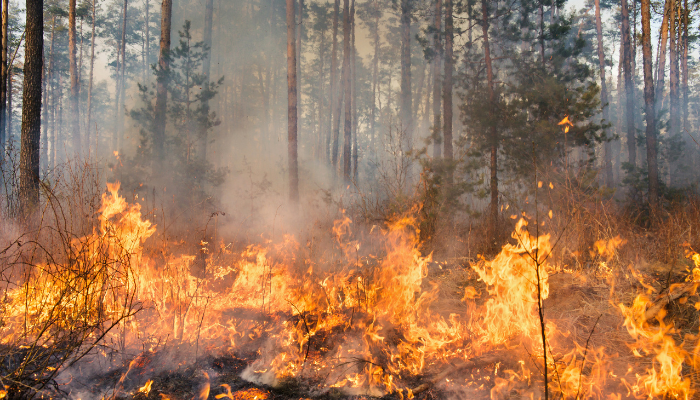Vigilance essential during current ‘Code Red’ forest fire warning

The current glorious weather that is set to last over the weekend provides an opportunity for all to recreate and enjoy. However, such weather patterns give rise to extreme fire risk. Teagasc Forestry advisors tell us more on the nature of such risks and offer practical advice on mitigating forest fire danger threats.
On Thursday last, July 10, 2025, the Department of Agriculture, Food and the Marine issued a Condition Red – Extreme Forest Fire Risk up to Monday July 14. Under such extreme fire risk conditions, any ignition source in dry vegetation will give rise to rapid and unpredictable wildfire development and spread. Such fires can be expected to cover extensive areas and pose extreme difficulties to suppression efforts and may potentially give rise to major emergency scenarios.
Such conditions require very high vigilance, particularly in areas with intensive public access and recreational use. It is critical that visitors to such areas cooperate with important fire safety requirements. Lighting open fires or barbeques in or around forest areas pose a huge risk and should not occur.
There is also a critical role for landowners and managers remaining vigilant to all potential fire risks and report suspicious activity to An Garda Síochána. Visitors to rural areas, forests and recreation sites are urged to cooperate with all requests regarding fire safety, observe good practice and be considerate in parking. This is to ensure emergency vehicle access is not impeded, a factor that could prove to be critical in protecting life and property.
Most forests will carry some level of fire risk but forested areas with surrounding moorland vegetation such as molinia grass, heather or gorse is particularly high risk as it dries extremely quickly and is highly flammable. Forest fires don’t tend to start naturally and are nearly always lit. Causes can include the inappropriate and/or illegal burning of scrub (prohibited under the Wildlife Act from March 1 to August 31), malicious intent, anti-social behaviour and carelessness.
The average area destroyed by fire annually in Ireland over the last 20 years or so is 250-300 hectares. As well as the obvious financial loss, there is the severe ecological cost to these valuable habitats. Forest fires can also put houses and indeed lives at risk so again, good planning around the risk of fire is extremely important.
Practical actions for forest owners
1) Have a fire plan in place
A Fire Plan is a simple document with some key information which provides efficiencies and speed if a fire occurs. Every forest owner should have a carefully prepared fire plan in place with copies available to neighbours, relevant foresters and the local fire service.
A good fire plan should include:
- A map of the forest showing local roads and access points
- A clear to-do list if a fire occurs
- Identified escape routes, assembly points
- Equipment locations and location of key, if in a locked shed
- Location and type of water sources
- Contact details for emergency services, local foresters/forestry company, and neighbours
2) Equipment
Have fire-fighting tools such as fire beaters, buckets, knapsack sprayers and pumps to hand and in good working order. These may be stored locally and might be shared with other forest owners.
3) Work with neighbours
Co-operation is vital. Talk to your neighbours and nearby forest owners regarding collaboration, including for monitoring and risk assessment. It is good to develop joint fire plans and share responsibility for guarding against fire risks.
4) Be vigilant
Be vigilant, especially during this current intense dry spell. Even a period of 24 hours is sufficient to dry out dead moorland vegetation. If fire is detected, summon help immediately and activate your fire plan. Do not rely on others to call the Fire Service.
5) Check firebreaks and access routes
Where protective firebreaks are in place around your forest, inspect them to ensure they are vegetation-free. Firebreaks should be at least 6 metres wide. Also, ensure access routes to your forest is in good order. If there is a locked forest gate in place, make sure the padlock is well oiled and that the well-marked key can easily be found.
6) Insure your forest
The Department of Agriculture, Food and the Marine (DAFM) requires beneficiaries of planting grants and premiums to sustainably manage and protect their forests. This includes an obligation to replant where a forest is damaged by fire. Therefore, make sure to have adequate insurance cover in place. Consider adequately insuring against re-establishment costs, loss of timber values and fire brigade call-out charges.
7) Report losses
If your forest is damaged by fire, you should report this to the nearest Garda Station and to the Forestry Division of the Department.
Visitors to the countryside and forests – Remember:
- Avoid parking across entrances that might impede emergency service access to forest roads
- Do not light fires in and around forests or open land
- Do not attempt to intervene or fight fires under any circumstances
- Telephone Fire and Rescue Services via 112 and report the fire and its location
